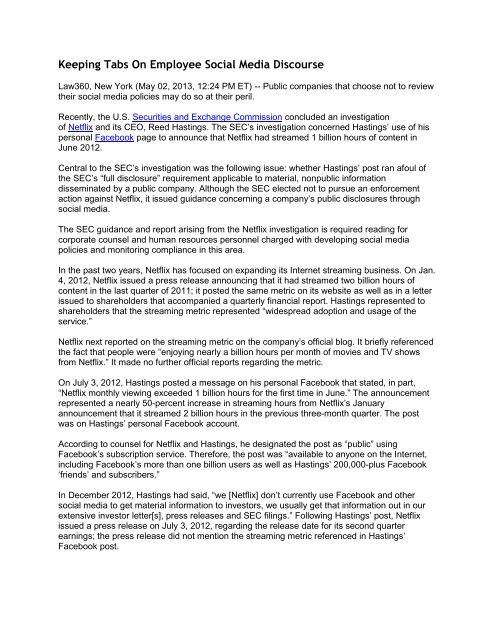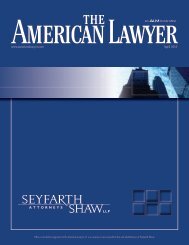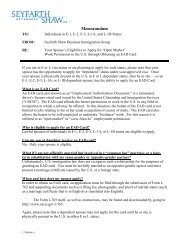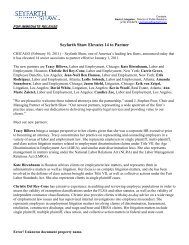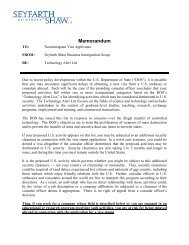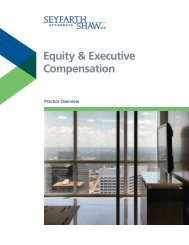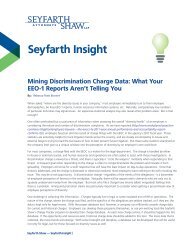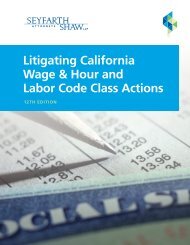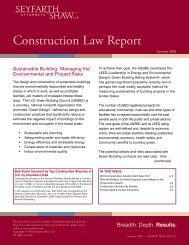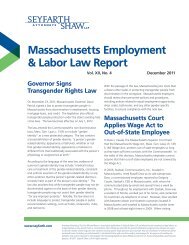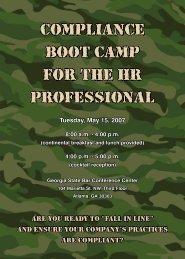here - Seyfarth Shaw LLP
here - Seyfarth Shaw LLP
here - Seyfarth Shaw LLP
Create successful ePaper yourself
Turn your PDF publications into a flip-book with our unique Google optimized e-Paper software.
Keeping Tabs On Employee Social Media Discourse<br />
Law360, New York (May 02, 2013, 12:24 PM ET) -- Public companies that choose not to review<br />
their social media policies may do so at their peril.<br />
Recently, the U.S. Securities and Exchange Commission concluded an investigation<br />
of Netflix and its CEO, Reed Hastings. The SEC’s investigation concerned Hastings’ use of his<br />
personal Facebook page to announce that Netflix had streamed 1 billion hours of content in<br />
June 2012.<br />
Central to the SEC’s investigation was the following issue: whether Hastings’ post ran afoul of<br />
the SEC’s “full disclosure” requirement applicable to material, nonpublic information<br />
disseminated by a public company. Although the SEC elected not to pursue an enforcement<br />
action against Netflix, it issued guidance concerning a company’s public disclosures through<br />
social media.<br />
The SEC guidance and report arising from the Netflix investigation is required reading for<br />
corporate counsel and human resources personnel charged with developing social media<br />
policies and monitoring compliance in this area.<br />
In the past two years, Netflix has focused on expanding its Internet streaming business. On Jan.<br />
4, 2012, Netflix issued a press release announcing that it had streamed two billion hours of<br />
content in the last quarter of 2011; it posted the same metric on its website as well as in a letter<br />
issued to shareholders that accompanied a quarterly financial report. Hastings represented to<br />
shareholders that the streaming metric represented “widespread adoption and usage of the<br />
service.”<br />
Netflix next reported on the streaming metric on the company’s official blog. It briefly referenced<br />
the fact that people were “enjoying nearly a billion hours per month of movies and TV shows<br />
from Netflix.” It made no further official reports regarding the metric.<br />
On July 3, 2012, Hastings posted a message on his personal Facebook that stated, in part,<br />
“Netflix monthly viewing exceeded 1 billion hours for the first time in June.” The announcement<br />
represented a nearly 50-percent increase in streaming hours from Netflix’s January<br />
announcement that it streamed 2 billion hours in the previous three-month quarter. The post<br />
was on Hastings’ personal Facebook account.<br />
According to counsel for Netflix and Hastings, he designated the post as “public” using<br />
Facebook’s subscription service. T<strong>here</strong>fore, the post was “available to anyone on the Internet,<br />
including Facebook’s more than one billion users as well as Hastings’ 200,000-plus Facebook<br />
‘friends’ and subscribers.”<br />
In December 2012, Hastings had said, “we [Netflix] don’t currently use Facebook and other<br />
social media to get material information to investors, we usually get that information out in our<br />
extensive investor letter[s], press releases and SEC filings.” Following Hastings’ post, Netflix<br />
issued a press release on July 3, 2012, regarding the release date for its second quarter<br />
earnings; the press release did not mention the streaming metric referenced in Hastings’<br />
Facebook post.
Similarly, Netflix’s June streaming metric was reported to the market in phases — by<br />
approximately noon on July 3, it was reported by a few news outlets; the same day, Netflix<br />
circulated the post to a few reporters but did not issue a press release; by the time the markets<br />
closed, the news was picked up by the mainstream financial press.<br />
Netflix's stock price began to rise on July 3 and July 4 following Hastings’ Facebook post.<br />
SEC Regulation of Disclosures of Material, Nonpublic Information<br />
Regulation Fair Disclosure (Regulation FD) requires that an issuer disclose material, nonpublic<br />
information to the securities market and its shareholders in a manner reasonably designed to<br />
achieve effective broad and nonexclusionary distribution to the public. Regulation FD was<br />
adopted out of the SEC’s concern that issuers were selectively disclosing important nonpublic<br />
information to select investors rather than making a full disclosure to the general public.<br />
In 2008, the SEC issued guidance confirming that Regulation FD applied to disclosures made<br />
on a company’s website. The SEC reasoned that websites could serve as an effective means<br />
for sharing information if investors have advance notice that the website is a potential means<br />
w<strong>here</strong> they can find important company information.<br />
The SEC’s April 2, 2013 Netflix report (called a “Rule 21(a) Report of Investigation”) extended<br />
the same advance notice logic to corporate disclosures made using social media.<br />
Netflix Dodges SEC Enforcement Action<br />
Ultimately, the SEC decided not to pursue an enforcement action, and it did not allege wrongful<br />
conduct against Netflix or Hastings. According to the SEC, the primary reason for leniency was<br />
because it learned during its investigation and through related public commentary that t<strong>here</strong> was<br />
“uncertainty concerning how Regulation FD and the Commission’s 2008 Guidance apply to<br />
disclosures made through social media.”<br />
Instead, the SEC issued a Section 21(a) Report of Investigation clarifying its view on the use of<br />
social media in the context of corporate disclosures and compliance with Regulation FD. The<br />
report addresses two critical issues: Public companies communicating to investors through<br />
social media channels must carefully analyze whether Regulation FD applies to those<br />
communications, and the SEC’s 2008 guidance applies with equal force to corporate<br />
disclosures made through social media channels.<br />
Specifically, public companies must provide advance notice to the public of the specific<br />
channels the company will use to disseminate material information.<br />
As the acting director of the SEC’s Division of Enforcement, George Canellos explained: “[m]ost<br />
social media are perfectly suitable methods for communicating with investors, but not if the<br />
access is restricted or if investors don’t know that’s w<strong>here</strong> they need to turn to get the latest<br />
news.”<br />
Employers Beware<br />
The SEC’s Rule 21(a) Report of Investigation assumed that an employee’s social media activity<br />
regarding his employer on the employee’s personal social media account (rather than through a<br />
corporate “page” or business account) may qualify as a corporate disclosure subject to fair<br />
2
disclosure regulations. Thus, employers may unwittingly violate the SEC’s full-disclosure<br />
requirements unless they take steps to guard against employees’ impulsive and inadvertent<br />
disclosures of material, nonpublic information through social media channels.<br />
The SEC’s current position on social media as a conduit for corporate disclosures places<br />
employers in a precarious position. The SEC assumed without much elaboration that a post<br />
relating to a business and financial metric on the personal Facebook page of Netflix’s CEO<br />
constituted a corporate disclosure. This is despite the SEC’s general agreement that “[p]ersonal<br />
social media sites of individuals employed by a public company would not ordinarily be<br />
assumed to be channels through which the company would disclose material corporate<br />
information.”<br />
In Netflix’s case, the SEC noted, “[n]either Hastings nor Netflix had previously used Hastings’<br />
Facebook page to announce company metrics … Instead, Netflix has consistently directed the<br />
public to its own Facebook page, Twitter feed, and blog and to its own web site for information<br />
about Netflix.”<br />
It seems that Netflix’s attempts to carve out social media as a means for making corporate<br />
disclosures did not help but hurt its case. Because the general investing public would not expect<br />
that Netflix would distribute important information through Hastings’ Facebook account, his<br />
personal post constituted a problematic “selective” corporate disclosure of “material” information<br />
to his 200,000-plus Facebook friends absent a corresponding press release or other<br />
communication to the general public specifically referencing the June streaming metric.<br />
In the SEC’s view, a company can be liable if certain employees post important company<br />
information on their personal social media accounts particularly w<strong>here</strong> the company has not<br />
designated social media as a “recognized channel of distribution” for communicating with its<br />
investors and w<strong>here</strong> an employer may not monitor or track its employees’ social media activity.<br />
In light of the Rule 21(a) Report of Investigation, employers need to examine their social media<br />
policies. Employers are especially at risk in connection with the private social media activity of<br />
top management especially their officers, directors or any individual who can be deemed to be<br />
the company’s mouthpiece.<br />
To avoid becoming the SEC’s next target in connection with fair disclosures, employers subject<br />
to SEC regulations should consider the following practical steps:<br />
Known Corporate Disclosures<br />
Companies who have formally adopted social media channels as a means to communicate with<br />
investors and shareholders should keep in mind:<br />
1. Evaluate Social Media Content<br />
Companies must evaluate any statements made through their social media channels in the<br />
context of Regulation FD. Specifically, companies must examine whether the disclosure<br />
concerns “material, nonpublic information.” If the answer is yes, then companies must determine<br />
whether the social media disclosure is “reasonably designed to provide broad, non-exclusionary<br />
distribution” to investors.<br />
2. Provide Advance Notice<br />
3
Companies using official social media accounts should define ways to alert the public of their<br />
use. For example, they can provide advance notice that social media is a “recognized channel<br />
of distribution” through press releases, SEC filings or investor websites. These communications<br />
should identify the social media channels that the company will use to disclose important,<br />
nonpublic information and the types of information that may be disclosed through these<br />
channels.<br />
“Inadvertent” Corporate Disclosures by Employees<br />
Companies should take steps to control potential risk of liability arising from the private social<br />
media activity of key officials and top management:<br />
1. Train Company’s Top Management and Spokespersons<br />
Companies should counsel officers, directors or other individuals who have access to the<br />
company’s business and financial metrics that posting information about the company on social<br />
media channels could implicate Regulation FD.<br />
2. Evaluate Social Media Policies<br />
Companies should consider oversight over social media used by those authorized to speak for<br />
the company (even if the individual is not a designated company spokesperson but may be<br />
deemed to speak for the company). However, such oversight can implicate the employees’<br />
privacy, First Amendment and potentially, their Section 7 rights pursuant to the National Labor<br />
Relations Act, among other rights, so companies need to tread with caution in this area.<br />
3. Consult the Experts<br />
A misstep can cost a company shareholder good will, diminish its market value and generate<br />
negative publicity if the company is subjected to costly enforcement actions. Given the rapidly<br />
changing and complex regulatory framework concerning social media, employers should consult<br />
counsel when developing, modifying or implementing their social media policies.<br />
--By Reema Kapur, <strong>Seyfarth</strong> <strong>Shaw</strong> <strong>LLP</strong><br />
Reema Kapur is an associate in the firm's Chicago office.<br />
The opinions expressed are those of the author and do not necessarily reflect the views of the<br />
firm, its clients, or Portfolio Media Inc., or any of its or their respective affiliates. This article is for<br />
general information purposes and is not intended to be and should not be taken as legal advice.<br />
4


